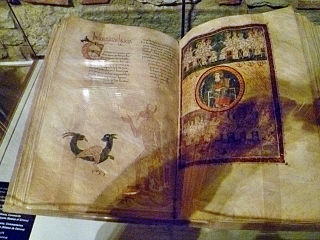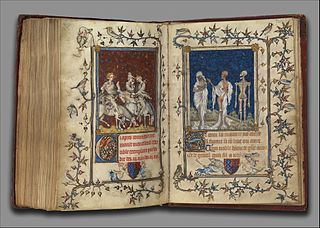
The Four Horsemen of the Apocalypse are figures in the Book of Revelation in the New Testament of the Bible, a piece of apocalypse literature attributed to John of Patmos, and generally regarded as dating to about AD 95. Similar allusions are contained in the Old Testament books of Ezekiel and Zechariah, written about six centuries prior. Though the text only provides a name for the fourth horseman, subsequent commentary often identifies them as personifications of Conquest (Zelos), War (Martius), Famine (Limos), and Death.

The Cloisters, also known as the Met Cloisters, is a museum in the Washington Heights neighborhood of Upper Manhattan, New York City. The museum, situated in Fort Tryon Park, specializes in European medieval art and architecture, with a focus on the Romanesque and Gothic periods. Governed by the Metropolitan Museum of Art, it contains a large collection of medieval artworks shown in the architectural settings of French monasteries and abbeys. Its buildings are centered around four cloisters—the Cuxa, Saint-Guilhem, Bonnefont and Trie—that were acquired by American sculptor and art dealer George Grey Barnard in France before 1913, and moved to New York. Barnard's collection was bought for the museum by financier and philanthropist John D. Rockefeller Jr. Other major sources of objects were the collections of J. P. Morgan and Joseph Brummer.

The Limbourg brothers were Dutch miniature painters from the city of Nijmegen. They were active in the early 15th century in France and Burgundy, working in the International Gothic style.

Beatus of Liébana was a monk, theologian, and author of the Commentary on the Apocalypse, mostly a compendium of previous authorities' views on the biblical Book of Revelation or Apocalypse of John. This had a local influence, mostly in the Iberian Peninsula, up to about the 13th century, but is today remembered mainly for the 27 surviving manuscript copies that are heavily illustrated in an often spectacular series of miniatures that are outstanding monuments of Mozarabic art. Examples include the Morgan Beatus and Saint-Sever Beatus; these are covered further at the article on the book. Most unusually for a work of Christian theology, it appears that Beatus always intended his book to be illustrated, and he is attributed with the original designs, and possibly the execution, of the first illustrations, which have not survived.

The Saint-Sever Beatus, also known as the Apocalypse of Saint-Sever, is a Romanesque Illuminated manuscript from the 11th century. The manuscript was made at Saint-Sever Abbey, then in the Duchy of Gascony, under the direction of Gregory of Montaner, abbot between 1028 and 1072. It is believed that the primary artist-scribe who illustrated the manuscript was Stephanus Garsia, working alongside other unnamed individuals.

The Bamberg Apocalypse is an 11th-century richly illuminated manuscript containing the pictorial cycle of the Book of Revelation and a Gospel Lectionary of the books of pericopes. This medieval illuminated manuscript was created during the Ottonian dynasty; it is unknown whether it was commissioned by Otto III or Henry II. It was completed sometime between 1000 and 1020. There is proof that Henry II donated this illuminated manuscript in 1020 to Collegiate Abbey of St. Stephan, on the occasion of its inauguration. The Bamberg Apocalypse is now located in the Bamberg State Library.

The Morgan Beatus is an illuminated manuscript with miniatures by the artist Magius of the Commentary on the Book of the Apocalypse by the eighth-century Spanish monk Beatus, which described the end of days and the Last Judgment. The manuscript is believed to have been produced in and around the scriptorium of the Monastery of San Miguel de Escalada in Spain.

The Stowe Psalter is a psalter from the "2nd or 3rd quarter of the 11th century", at the end of Anglo-Saxon art. The text includes the Gallican version of the Psalms, followed by the Canticles with an interlinear Old English gloss.

The Hours of Jeanne d'Evreux is an illuminated book of hours in the Gothic style. According to the usual account, it was created between 1324 and 1328 by Jean Pucelle for Jeanne d'Evreux, the third wife of Charles IV of France. It was sold in 1954 to the Metropolitan Museum of Art in New York where it is now part of the collection held at The Cloisters, and usually on display.

The Escorial Beatus is a 10th-century illuminated manuscript of the Commentary on the Apocalypse by Beatus of Liébana. The manuscript was probably created at the monastery at San Millán de la Cogolla. There are 151 extant folios which measure 395mm by 225mm. The manuscript is illustrated with 52 surviving miniatures. Of the original illustrations within the commentary, twenty-seven of the original illustrations are left. Compared to other illuminated manuscripts, including other illuminated manuscripts at the time, the Escorial Beatus is slightly smaller in comparison. The Escorial Beatus is one of the most well-known illuminated manuscripts that make use of the Mozarabic style of art. This would later lead to influence other well known artistic styles, including styles like Romanesque and Carolingian.

The Commentary on the Apocalypse is a Latin commentary on the biblical Book of Revelation written around 776 by the Spanish monk and theologian Beatus of Liébana. The surviving texts differ somewhat, and the work is mainly famous for the spectacular illustrations in a group of illustrated manuscripts, mostly produced on the Iberian Peninsula over the following five centuries. There are 29 surviving illustrated manuscripts dating from the 9th to the 13th centuries, as well as other unillustrated and later manuscripts. Significant copies include the Morgan, Saint-Sever, Gerona, Osma, Madrid, and Tábara Beatus codices.

The Apocalypse, properly Apocalypse with Pictures, is a 1498 printed book by Albrecht Dürer containing fifteen woodcuts accompanied by text. The book depicts scenes from the Book of Revelation, and rapidly brought Dürer fame across Europe. These woodcuts likely drew on theological advice, particularly from Johannes Pirckheimer, the father of Dürer's friend Willibald Pirckheimer.

The Gerona Beatus is a 10th-century illuminated manuscript in the museum of Girona Cathedral, Catalonia, Spain.

The Petites Heures of Jean de France, Duc de Berry is an illuminated book of hours commissioned by John, Duke of Berry between 1375 and 1385–90. It is known for its ornate miniature leaves and border decorations.

The Urgell Beatus, Beatus d'Urgell or Beatus la Seu d'Urgell is a 10th-century illuminated manuscript of the Commentary on the Apocalypse by the 8th-century monk Beatus of Liebana, now in the Musei Diocesá de La Seu d'Urgell, at La Seu d'Urgell, Spain.

The Psalter of Bonne de Luxembourg is a small 14th-century illuminated manuscript in tempera, grisaille, ink and gold leaf on vellum. It is held in the collection of The Cloisters, New York, where it is usually on display.

The San Millán Beatus is an illuminated manuscript now held in the Royal Academy of History in Madrid as Cod. Emil. 33. It measures 35.5 cm by 23 cm and is a copy of the Commentary on the Apocalypse by Beatus of Liébana. Its illuminations are incomplete, but its text is one of the most complete surviving copies of the commentary. As well as Beatus' commentary, it contains saint Jerome's prologue on the Apocalypse and commentary on the Book of Daniel and extracts from Isidore of Seville's Etymologiae. It is made up of 282 bound folios - there are 48 miniatures on the first 228 pages and 1 miniature on the remaining 54 pages.

The Tábara Beatus or Beatus of Tábara is a 10th-century illuminated manuscript, containing the Commentary on the Apocalypse by Beatus of Liébana. It originated in the San Salvador de Tábara Monastery and is now held in Spain's National Historical Archive in Madrid under the catalogue number L.1097B. Only eight of its original hundred miniatures survive.

Miniature Altarpiece with the Crucifixion is a very small and complex early 16th century Netherlandish microcarved miniature sculpture in boxwood, now in The Cloisters, New York. The central carvings of the upper triptych show the Crucifixion and Resurrection of Jesus; each outer wing contains two scenes from the biblical Old Testament. The complex base contains a round carving which opens like a boxwood prayer nut.

The Clement Bible is a deluxe illustrated manuscript of the Vulgate Bible produced in Naples around 1330. It is a pandect.




























